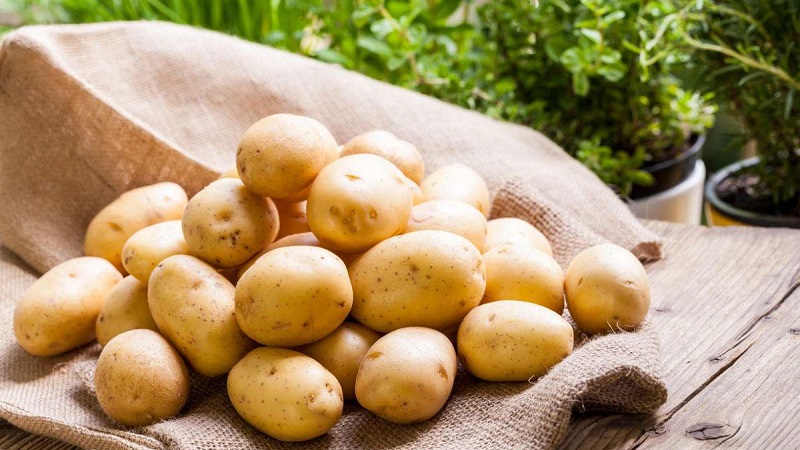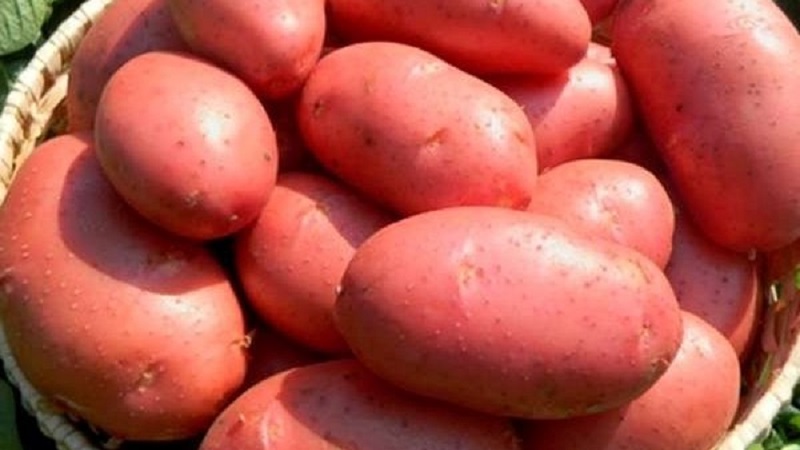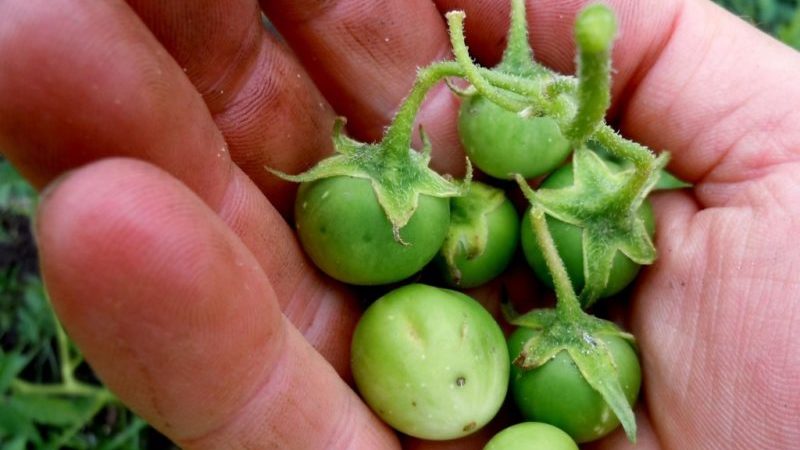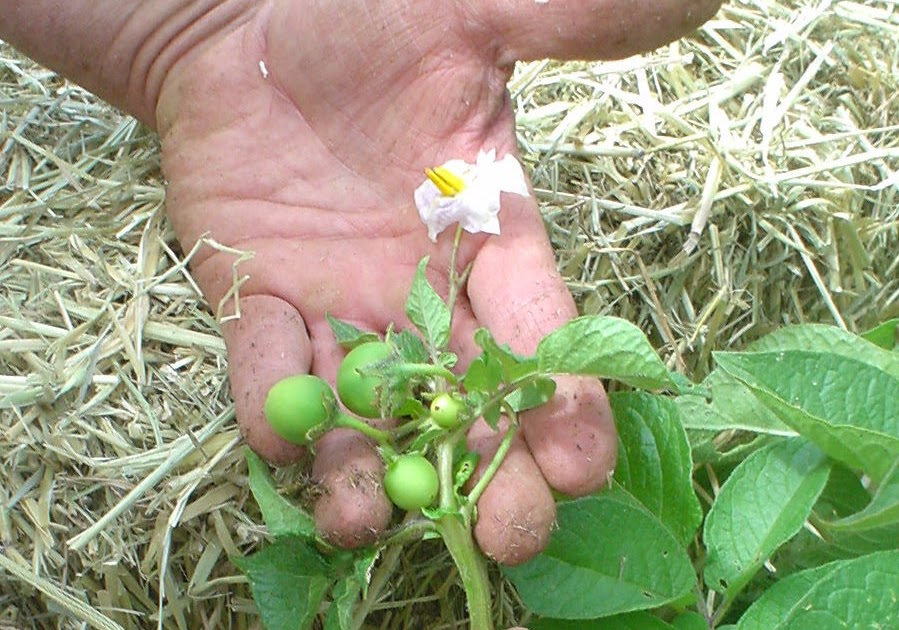When and how to properly collect potato seeds from berries
Collecting potato seeds from berries is a troublesome and complicated procedure. If you collect, store and prepare for planting seeds in accordance with all the rules, you will be able to get a larger crop of potatoes at the output, which will not be susceptible to diseases and pest attacks.
The content of the article
Potato varieties for seed propagation
After flowering, all potato bushes are covered with berries, from which seeds are collected.
Certain varieties produce more fruits, and their seeds are distinguished by increased germination:
- Farmer. Potatoes with a thin, light skin, the flesh does not disintegrate during cooking. The crop is harvested 65 days after planting. Each bush bears fruit with 10-15 potatoes weighing about 100 g. Resistant to viral diseases.
 Farmer
Farmer - Assol. Oval tubers with a smooth, light skin. The pulp is dense, light yellow. Young potatoes are dug up in mid-July, and the entire crop is harvested in August. The variety is resistant to diseases and sudden changes in temperature. The weight of each tuber is from 100 g and above. More than 3 kg of the crop is harvested from the bush.
- The empress. Small bushes with large elongated tubers. The pulp is yellowish, the taste is high. The weight of vegetables is from 60 to 140 g; 3.3 kg of potatoes are usually harvested from the bush. The first harvest is dug up in July, harvesting is completed at the end of August. The plant is resistant to fungal diseases, practically not affected by the nematode.
- Triumph. Small oval tubers. Differs in increased productivity: each bush bears fruit not less than 30 potatoes. Creamy pulp is good - great for soups and for baking. The culture has an increased immunity to viral and fungal diseases.
- Ilona. Full ripening occurs in August. Young potatoes begin to be dug up in July. Tubers are large, elongated, beige. The pulp is crumbly white. High productivity, resistance to diseases and pests, good germination in various climatic conditions.
- Velina. Oval tubers of medium size, pale yellow color, dense foliage. Potatoes sprout quickly and are harvested in August. Vegetables are suitable for preparing various dishes. Each bush gives 500-700 g of tubers. There is immunity to fungi and viruses.
- Revenge. Large oval tubers weighing 120 g. One bush gives up to 3 kg of yield. Smooth yellow rind, creamy pulp, which does not darken during heat treatment. Resistant not only to common diseases, but also to pests.
- Lada. Produces round tubers that keep well throughout the winter. The peel is reddish, the flesh is light yellow starchy. One tuber weighs up to 150 g. The variety has increased resistance to common diseases.
- Beauty. Mid-season high-yielding variety. Large red tubers weigh up to 300 g each. The yellow flesh does not crumble during cooking. The plant is resistant to fungal diseases and temperature changes.
 Beauty
Beauty - Virgo. Large elongated tubers weighing up to 200 g, light red peel. The pulp is yellow, boiled. There is immunity to infections and pests.
Seed planting benefits
Growing a crop from seeds has a number of advantages over classic tuber propagation:
- there are no diseases that occur in tubers;
- buying seeds is cheaper than planting potatoes;
- the yield is 10–20% higher than that obtained from tubers;
- the shelf life of planting material is more than 5 years, it does not require much space;
- grown potatoes are more resistant to late blight and other diseases.
The potatoes grown from seeds are small in the first year, but they are used for planting in the next season.
How to get potato seeds at home
Buying in specialized stores is easier, but it will not guarantee good quality and high germination.
Self-picking requires extra effort, but allows you to get potatoes with increased yields and resistance to diseases.
When to collect seeds

To obtain a large number of healthy seeds, the berries are harvested from the strongest bushes that have not hurt for the entire season.
Reference! To prevent the loss of berries, the top of the bush is wrapped with a vegetable net. This will prevent dropping and facilitate collection.
The seeds are found in the berries remaining after the potato has flowered. So that the fruits do not fall off, they are harvested immature in mid-July. For early maturing varieties, the harvest time begins in June. Their color should be light green at this time.
How to collect potato seeds from bulbs
The collected berries are carefully laid out in one layer or hung in a bag of gauze in a bright and warm place. Leave for several weeks until fully ripe and softened.

Next steps:
- Ripe berries are turned into porridge, crushing them. A small amount of water is added to the mass. Leave in a warm place for 2-3 days for fermentation (bubbles and a strong characteristic odor should appear).
- Fermented gruel is poured with plenty of water. Seeds that are suitable for planting will sink to the bottom. All defective material will rise to the surface.
- Empty seeds are removed from the surface.
- To separate the seed material from the water, filter the entire mass through cheesecloth or a fine sieve.
The planting material is also removed in a simpler way: the fruits cut in half are ground on a sheet of paper and allowed to dry. After evaporation of the pulp, only seeds remain on the leaf. The disadvantage of this method is the lack of fermentation, which destroys the dense seed coat, which prevents the rapid emergence of plants.
Features of the workpiece
After separating the seeds from the pulp, they are washed in clean water to remove the remaining fruit. To dry, the material is laid out on a thick, clean sheet of paper in a thin layer and left in a warm room without drafts.
Dried seeds are packaged in paper envelopes indicating the name of the potato variety and the date of collection. Seed material is stored for up to 8 years, but specimens not older than 2 years give the highest germination.
Storage and preparation for planting
Packaged seeds are stored in dry rooms with a temperature of + 12 ... + 18 ° C.
Advice! Keep the material out of the reach of rodents, as they use some of the seeds for food, and some will spoil.
Before planting, it is better to prepare the seeds to awaken and harden them:
- To wake up, they are poured with warm water and left for 48 hours in a warm room.
- They are taken out of water and dried naturally to a free-flowing state.
- For hardening, it is wrapped in a damp cloth and left for 14 days. The fabric is regularly moistened, kept indoors during the day, put in the refrigerator overnight.
The appearance of sprouts is a sign that it is time to plant the seeds in the ground.
Conclusion
It takes a lot of time and effort to grow potatoes from seeds. However, self-collection and preparation of seed material for planting provide a guarantee of obtaining disease-resistant potatoes and a high yield with large tubers.